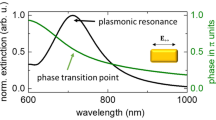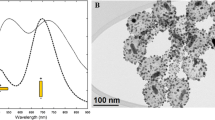Abstract
Gold nanorod has been shown to exhibit two distinct plasmon resonances in extinction spectra, a transverse mode and a longitudinal mode, which can be tuned by changing the aspect ratio of length and width. What will happen when a nanorod with a constant aspect ratio compounds with semispheres? A theoretical model that combines gold nanorod and semispheres constructing a dumbbell-shaped nanorod is performed in this paper. We report a detailed theoretical investigation on how the nanostructures with a cavity based on gold nanorods can tune the optical properties and enhance localized field. The results show that the topography of the nanorods provides other degrees of freedom to tune the optical properties. Indeed, when the direction of incident light is along the x-axis, the resonance frequency and spectral width of longitudinal modes can be tuned in a wide wavelength range by varying the radius of semisphere-suspended heads. The resonance modes in the infrared zone can be significantly tuned up to 800 nm by varying the radius of semispheres. Also, the field distribution of the dumbbell-shaped nanorod can be significantly changed by plasmon excitement of semisphere-suspended heads. Field amplification up to four orders of magnitude can be obtained, which can provide a new path to tune the optical response of the nanorod and will have wide applications in localized surface plasmon resonance (LSPR)-based biosensing and intracellular imaging and photothermal therapy.








Similar content being viewed by others
References
Smythe EJ, Cubukcu E, Capasso F (2007) Optical properties of surface plasmon resonances of coupled metallic nanorods. Opt Express 15:7439–7447
Zou S, Schatz GC (2005) Silver nanoparticle array structures that produce giant enhancements in electromagnetic fields. Chem Phys Lett 403:62–67
Slaughter LS, Wu Y, Willingham BA, Nordlander P, Link S (2010) Effects of symmetry breaking and conductive contact on the plasmon coupling in gold nanorod dimers. ACS Nano 4:4657–4666
Maier SA, Atwater HA (2005) Plasmonics: localization and guiding of electromagnetic energy in metal/dielectric structures. J Appl Phys 98:11101
Murphy CJ, Sau TK, Gole AM, Orendorff CJ, Gao J, Gou L, Hunyadi SE, Li T (2005) Anisotropic metal nanoparticles: synthesis, assembly, and optical applications. J Phys Chem B 109:13857–13870
Ming T, Zhao L, Chen H, Woo KC, Wang J, Lin HQ (2011) Experimental evidence of plasmophores: plasmon-directed polarized emission from gold nanorod–fluorophore hybrid nanostructures. Nano Lett 11:2296–2303
Bai Z, Chen R, Si P, Huang Y, Sun H, Kim DH (2013) Fluorescent pH sensor based on Ag@ SiO2 core-shell nanoparticle. ACS Appl Mater Interfaces 5:5856–5860
Schuller JA, Barnard ES, Cai WS, Jun YC, White JS, Brongersma ML (2010) Plasmonics for extreme light concentration and manipulation. Nat Mater 9:193–204
Boca SC, Astilean S (2010) Detoxification of gold nanorods by conjugation with thiolated poly (ethylene glycol) and their assessment as SERS-active carriers of Raman tags. Nanotechnology 21:235601
Durr NJ, Larson T, Smith DK, Korgel BA, Sokolov K, Ben-Yakar A (2007) Two-photon luminescence imaging of cancer cells using molecularly targeted gold nanorods. Nano Lett 7:941–945
Lee SE, Sasaki DY, Perroud TD, Yoo D, Patel KD, Lee LP (2009) Biologically functional cationic phospholipid-gold nanoplasmonic carriers of RNA. J Am Chem Soc 131:14066–14074
Liao H, Hafner JH (2005) Gold nanorod bioconjugates. Chem Mater 17:4636–4641
Huang X, El-Sayed IH, Qian W, El-Sayed MA (2007) Cancer cells assemble and align gold nanorods conjugated to antibodies to produce highly enhanced, sharp, and polarized surface Raman spectra: a potential cancer diagnostic marker. Nano Lett 7:1591–1597
Cong B, Kan C, Wang H, Liu J, Xu H, Ke S (2014) Gold nanorods: near-infrared plasmonic photothermal conversion and surface coating. J Mater Sci Chem Eng 2:20
Vigderman L, Khanal BP, Zubarev ER (2012) Functional Au nanorods: synthesis, self-assembly and sensing applications. Adv Mater 24:4811–4841
Nepal D, Park K, Vaia RA (2012) High-yield assembly of soluble and stable gold nanorod pairs for high-temperature plasmonics. Small 8:1013–1020
Zhang LB, Zhou X, Bao SX, Shi YF, Wang Y (2011) Rational design and SERS properties of side-by-side, end-to-end and end-to-side assemblies of Au nanorods. J Mater Chem 21:14448–14455
Nie Z, Petukhova A, Kumacheva E (2010) Properties and emerging applications of self-assembled structures made from inorganic nanoparticles. Nat Nanotechnol 5:15–25
Grzelczak M, Vermant J, Furst EM, Liz-Marzan LM (2010) Directed self-assembly of nanoparticles. ACS Nano 4:3591–3605
Halas NJ, Lal S, Chang W-S, Link S, Nordlander P (2011) Plasmons in strongly coupled metallic nanostructures. Chem Rev 111:3913–3961
Funston AM, Novo C, Davis TJ, Mulvaney P (2009) Plasmon coupling of gold nanorods at short distances and in different geometries. Nano Lett 9:1651–1658
Nie Z, Fava D, Kumacheva E, Zou S, Walker GC, Rubinstein M (2007) Self-assembly of metal–polymer analogues of amphiphilic triblock copolymers. Nat Mater 6:609–614
Ozbay E (2006) Plasmonics: merging photonics and electronics at nanoscale dimensions. Science 311:189–193
Fava D, Nie Z, Winnik MA, Kumacheva E (2008) Evolution of self-assembled structures of polymer-terminated gold nanorods in selective solvents. Adv Mater 20:4318–4322
Xu X, Yi Z, Li X, Wang Y, Geng X, Luo J, Luo B, Yi Y, Tang Y (2012) Discrete dipole approximation simulation of the surface plasmon resonance of core/shell nanostructure and the study of resonance cavity effect. J Phys Chem C 116:24046–24053
Prodan E, Nordlander P (2003) Structural tunability of the plasmon resonances in metallic nanoshells. Nano Lett 3:543–547
Alexander KD, Skinner K, Zhang S, Wei H, Lopez R (2010) Tunable SERS in gold nanorod dimers through strain control on an elastomeric substrate. Nano Lett 10:4488–4493
Kinkhabwala A, Yu ZF, Fan SH, Avlasevich Y, Mullen K, Moerner WE (2009) Large single-molecule fluorescence enhancements produced by a bowtie nanoantenna. Nat Photonics 3:654–657
Ueno K, Juodkazis S, Mizeikis V, Sasaki K, Misawa H (2008) Clusters of closely spaced gold nanoparticles as a source of two-photon photoluminescence at visible wavelengths. Adv Mater 20:26–30
Grigorenko AN, Roberts NW, Dickinson MR, Zhang Y (2008) Nanometric optical tweezers based on nanostructured substrates. Nat Photonics 2:365–370
Draine BT, Flatau PJ (1994) Discrete-dipole approximation for scattering calculations. J Opt Soc Am A 11:1491–1499
Yurkin MA, Hoekstra AG (2007) The discrete dipole approximation: an overview and recent developments. J Quant Spectrosc Radiat Transf 106:558–589
Draine BT, Flatau PJ http://arXiv.org/abs/1002.1505v1 (accessed 2010)
Draine BT, Flatau PJ (2008) Discrete-dipole approximation for periodic targets: theory and tests. J Opt Soc Am A 25:2693–2703
Zhao J, Pinchuk AO, McMahon JM, Li SZ, Alisman LK, Atkinson AL, Schatz GC (2008) Methods for describing the electromagnetic properties of silver and gold nanoparticles. Acc Chem Res 41:1710–1720
Purcell EM, Pennypacker CR (1973) Scattering and absorption of light by nonspherical dielectric grains. Astrophys J 186:705–714
Palik ED (1985) Handbook of optical constants of solids. Academic, New York
Acknowledgments
The work is financially supported by the Fundamental Research Funds for the Central Universities of Central South University (grant no. 2013zzts011), the Open-End Fund for the Valuable and Precision Instruments of Central South University (CSUZC2014024), the National Nature Science Foundation of China (grant no. 11375159), and the Science and Technology Foundation of CAEP (grant no. 2012B0302051)
Author information
Authors and Affiliations
Corresponding authors
Rights and permissions
About this article
Cite this article
Xu, Xb., Luo, Js., Liu, M. et al. Cavity-Induced NIR Tunability in Optical Response and Energy Confinement of Dumbbell-Shaped Au Nanorod. Plasmonics 10, 369–381 (2015). https://doi.org/10.1007/s11468-014-9818-9
Received:
Accepted:
Published:
Issue Date:
DOI: https://doi.org/10.1007/s11468-014-9818-9




